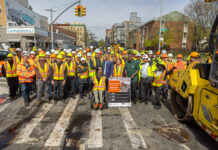The Commercial Observer has published a comprehensive report asserting that non-union employees are gaining ground in construction work in the NYC area. The headline, Organized Labor Doesn’t Have the Grip They Once Did Thanks to ‘Open Shop’ indicates that high costs within the construction sector are driving the trend to larger projects using a mis of union and non-union labor.
“New York is becoming an open-shop town.”
That’s what Jay Badame, the president and chief operating officer of AECOM Tishman, said at a panel discussion late last month at the Union League Club in Midtown South hosted by the law firm Zetlin & De Chiara.
It was a blunt assessment from the head of the city’s largest construction management company.
Examples of open shop projects include:
Essex Crossing, a 1.9 million sq. ft. office, residential and retail projects in nine buildings, developed by a consortium of L+M Development Partners, BFC Partners and Taconic Investment Partners. (L+M Builders Group –a L+M subsidiary — and T.J. Nickel are general contractors.)
1 Wall Street, a residential conversion of the 944,000 sq. ft. building, including interior demolition and preconstruction services. Gilbane Building Company was the general contractor for the first phase of the work on the Macklowe Properties initiative.
333 Schemerhorn St. in Boerum Hill, Brooklyn (the Hub) was completed through open shoop by New Line Structures.
The article indicates that much of the open shop activity for larger projects is an extension of the traditional non-union relationships for smaller-scale residential projects.
Organized labor representatives assert that the bulk of non-residential work within NYC remains unionized, and even in the Open Shop environment, the majority of the workers on site belong to the building trades.
Gary LaBarbera, the president of the Building Trades Council of Greater New York, which represents more than 100,000 union workers, contends that small housing projects across the outer boroughs have historically been done nonunion, and as a result unions aren’t actually losing market share.
“(Open shop) is just in the residential marketplace. For decades there has always been a nonunion presence,” LaBarbera told CO. “I’m sure you get calls from REBNY and my friends over there, and I say that sarcastically, because they’re pushing that the unions are losing strength in the area.”
At the same time, LaBarbera pointed out that many open-shop projects have a strong union presence—in some cases “70 percent or 80 percent” union workers, making them essentially union sites.










